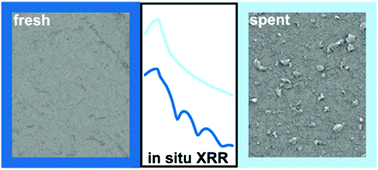In situ studies of the cathodic stability of single-crystalline IrO2(110) ultrathin films supported on RuO2(110)/Ru(0001) in an acidic environment†
Abstract
We investigate with in situ surface X-ray diffraction (SXRD) and X-ray reflectivity (XRR) experiments the cathodic stability of an ultrathin single-crystalline IrO2(110) film with a regular array of mesoscopic rooflike structures that is supported on a RuO2(110)/Ru(0001) template. It turns out that the planarity of the single-crystalline IrO2(110) film is lost in that IrO2(110) oxide domains delaminate at a cathodic potential of −0.18 V. Obviously, the electrolyte solution is able to reach the RuO2(110) layer presumably through the surface grain boundaries of the IrO2(110) layer. Subsequently, the single-crystalline RuO2(110) structure-directing template is reduced to amorphous hydrous RuO2, with the consequence that the IrO2(110) film loses partly its adhesion to the template. From in situ XRR experiments we find that the IrO2(110) film does not swell upon cathodic polarization down to −0.18 V, while from in situ SXRD experiments, the lattice constants of IrO2(110) are shown to be not affected. The rooflike mesostructure of the IrO2(110) flakes remains intact after cathodic polarization to −0.18 V, evidencing that the crystallinity of IrO2(110) is retained.

- This article is part of the themed collection: 2020 PCCP HOT Articles


 Please wait while we load your content...
Please wait while we load your content...